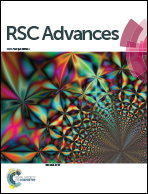A double network strategy to improve epithelization of a poly(2-hydroxyethyl methacrylate) hydrogel for corneal repair application
Abstract
To enhance the epithelization of poly(2-hydroxyethyl methacrylate) hydrogels and provide a biocompatible alternative for keratoplasty, this paper presents a novel double network scaffold and its preparation methods, in which a cell-affinitive hydrogel was made by poly(2-hydroxyethyl methacrylate) and modified gelatin. Methacrylic anhydride modified gelatin was interpenetrated into the as-prepared poly-2-hydroxyethyl methacrylate to form a porous double network to facilitate cell behavior on the hydrogels. Physico-chemical measurements such as X-ray photoelectron spectroscopy, transparency, swelling ratio, scanning electron microscopy, thermal gravimetric analysis as well as dynamic mechanical analysis have been performed in order to correlate the material composition with the corresponding properties. The in vitro cell assays of the porous double networks revealed that cells remained viable and, depending on the composition, were able proliferate, as was demonstrated by the deposition of gelatin. All of these results demonstrated that these porous double networks possess more advantages compared with poly(2-hydroxyethyl methacrylate) alone and improved epithelization due to methacrylated gelatin. The obtained double network scaffold could act as an attractive material for corneal repair application.


 Please wait while we load your content...
Please wait while we load your content...